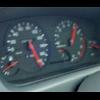Clutch Questions
Announcements
-
Similar Content
-
Latest Posts
-
Yes. It's either "2 wires", or 1 wire, depending on how you look at it. It is the connection that ties the battery -ve to both the chassis and the engine. Every electron that goes in or out of the battery goes through those 2 small spots (on the inner guard and on the engine block). If those are not clean and tight, then shit starts to suffer. Yeah, but measure it again cold in the morning, after it has had hours to rest. You can't usefully test the charge state of a battery immediately after it has been running because the alternator puts a surface charge onto the plates that takes a while to soak in and balance out. It will always read higher, and potentially look properly healthy, when fresh off of charge. But hours later it can look a lot less healthy. It's also worth measuring the battery voltage while cranking, although this can be difficult with a typical DMM because the screem update rate is so slow on most of them. An analogue voltmeter is actually a better tool for that. If the voltage drops too far while cranking, it is a sign of a poor battery. Although I don't think we're necessarily looking for a weak battery here - just wanting to exclude it.
-
https://www.facebook.com/share/15ZMn5oXtc/ Updated Event (so its not private and can be shared easier) Attempting to coordinate a big push of Stagea's to this years GTR Festival. Great event last year and hoping for the same this year. Discounted tickets 20% off for their various tickets until the 3rd of Feb Monday. Drags, show and shine etc. I've emailed them to ask to set a location aside for the Stageas for the show and shine - they are happy to do so if we can get them numbers, I'm happy to keep track of that. Entering as Nismo category. I'll be road tripping up from Melbourne, would be cool to convey if people are interested, maybe there is SAU convoys from each capital? If you have ideas about that let me know. https://gtrfestival.com.au
-
Does have series 2 airbag steering wheel and passenger side airbag also.
-
Do I have a series 2 or has someone spent money to have a series 1/1.5 look like a series 2? Everything I have read says the series 2 came out in 1996. I have a car manufactured in December 1995. The exterior, engine and interior are all series 2 other than the dash facia is series 1. Paint code is also kr4 that I believe is only available on a series 2. I have a VX Vehicle History Report and it says Grade: GTS25T TYPE M2 Manufacture date: 1995-12 Make: NISSAN Model: SKYLINE Body: E-ECR33 Grade: GTS25T TYPE M2 Engine: RB25DET Drive: 2WD Transmission: F5
-
I went to Repco to get them to test the battery using their tester (not a volt meter), alternator shows 14.3v when running, and when the car was off after the it was on full load I think it was 12.6v but the guy said it was all good. Terminals are all clean, no corrosion. Though I coulda sworn when I tightened up my alternator belt the car idles a bit higher and the steering wheel shakes a bit until it's warmed up. I wanted to confirm for the earth cable/s, are you referring to the 2 wires that are bolted onto the frame rail under the battery? I might be overthinking this a bit.
-






Recommended Posts
Create an account or sign in to comment
You need to be a member in order to leave a comment
Create an account
Sign up for a new account in our community. It's easy!
Register a new accountSign in
Already have an account? Sign in here.
Sign In Now